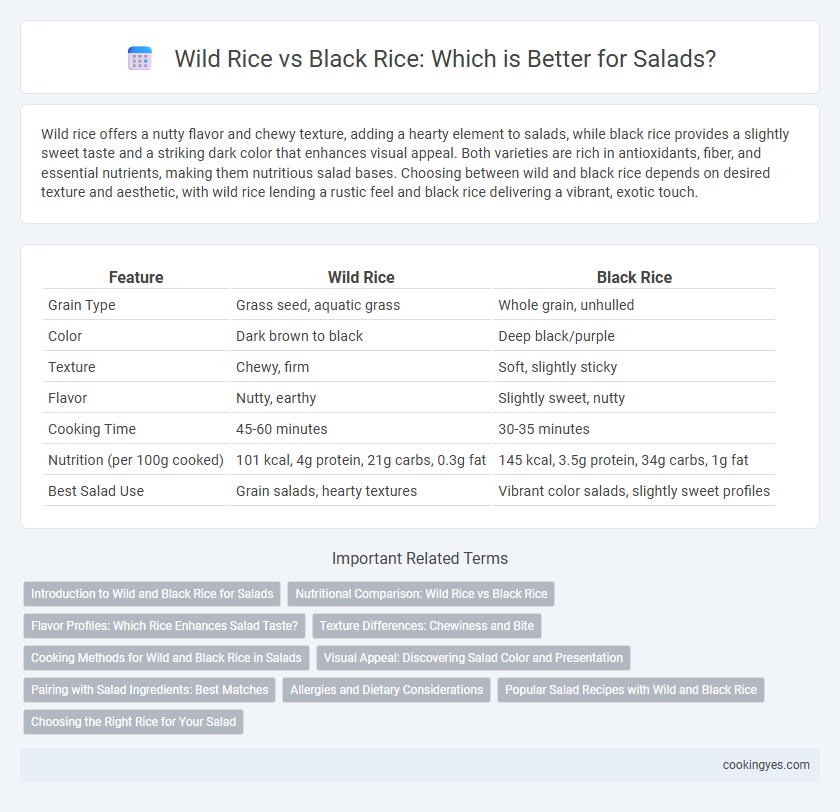Wild rice offers a nutty flavor and chewy texture, adding a hearty element to salads, while black rice provides a slightly sweet taste and a striking dark color that enhances visual appeal. Both varieties are rich in antioxidants, fiber, and essential nutrients, making them nutritious salad bases. Choosing between wild and black rice depends on desired texture and aesthetic, with wild rice lending a rustic feel and black rice delivering a vibrant, exotic touch.
Table of Comparison
| Feature | Wild Rice | Black Rice |
|---|---|---|
| Grain Type | Grass seed, aquatic grass | Whole grain, unhulled |
| Color | Dark brown to black | Deep black/purple |
| Texture | Chewy, firm | Soft, slightly sticky |
| Flavor | Nutty, earthy | Slightly sweet, nutty |
| Cooking Time | 45-60 minutes | 30-35 minutes |
| Nutrition (per 100g cooked) | 101 kcal, 4g protein, 21g carbs, 0.3g fat | 145 kcal, 3.5g protein, 34g carbs, 1g fat |
| Best Salad Use | Grain salads, hearty textures | Vibrant color salads, slightly sweet profiles |
Introduction to Wild and Black Rice for Salads
Wild rice offers a nutty flavor and chewy texture that enhances salad complexity, while black rice provides a slightly sweet taste and striking deep purple color, making salads visually appealing. Both rice varieties are rich in antioxidants, fiber, and essential nutrients, supporting digestive health and sustained energy. Incorporating wild or black rice into salads boosts nutritional value and adds unique texture contrasts compared to traditional white rice.
Nutritional Comparison: Wild Rice vs Black Rice
Wild rice contains higher protein content and more fiber, making it beneficial for digestion and satiety, while black rice is rich in antioxidants such as anthocyanins that support heart health and reduce inflammation. Both types offer essential minerals like magnesium, phosphorus, and iron, but wild rice typically has fewer calories and carbs per serving compared to black rice. Choosing between wild and black rice for salads depends on whether you prioritize protein and fiber intake or antioxidant benefits.
Flavor Profiles: Which Rice Enhances Salad Taste?
Wild rice offers a nutty, earthy flavor with a slightly chewy texture that adds depth and complexity to salads. Black rice delivers a mildly sweet, robust taste with a firm bite, enhancing salad freshness and visual appeal. Choosing between wild and black rice depends on whether a salad benefits more from earthiness or subtle sweetness.
Texture Differences: Chewiness and Bite
Wild rice offers a firm, chewy texture with a distinctive bite that holds up well in salads, providing a satisfying contrast to softer ingredients. Black rice, often called forbidden rice, has a slightly sticky texture with a tender bite, creating a silkier mouthfeel in salad preparations. These texture differences make wild rice ideal for adding crunch and structure, while black rice lends a smoother, more cohesive element to mixed salads.
Cooking Methods for Wild and Black Rice in Salads
Wild rice requires a longer cooking time of about 45-60 minutes to achieve a chewy texture ideal for hearty salads, while black rice cooks faster, typically in 30-35 minutes, resulting in a slightly sticky consistency that holds dressings well. Both types benefit from rinsing before cooking to remove excess starch, enhancing their respective textures in salad dishes. Cooling the rice completely after cooking helps maintain firmness and prevents salads from becoming mushy.
Visual Appeal: Discovering Salad Color and Presentation
Wild rice, with its long, dark grains and nutty flavor, adds a striking contrast and crunchy texture to salads, enhancing visual appeal through deep hues that complement vibrant greens and reds. Black rice, often called forbidden rice, offers a glossy, jet-black appearance that turns salads into visually dramatic dishes while providing a slightly sweet, earthy flavor. Mixing wild and black rice creates a colorful presentation with varying textures, making salads both visually enticing and flavorful.
Pairing with Salad Ingredients: Best Matches
Wild rice offers a nutty, earthy flavor that pairs exceptionally well with ingredients like cranberries, pecans, and feta, enhancing salads with a robust texture and complexity. Black rice, known for its slightly sweet, chewy grains, complements fresh vegetables such as bell peppers, cucumber, and avocado, adding color contrast and a subtle sweetness. Combining wild or black rice with citrus dressings, fresh herbs, and crunchy nuts elevates salad profiles, balancing flavors with rich textures.
Allergies and Dietary Considerations
Wild rice is a good choice for salads due to its gluten-free status and low allergenic potential, making it suitable for those with celiac disease or gluten sensitivity. Black rice, also gluten-free, contains higher levels of anthocyanins, which offer antioxidant benefits but may pose allergenic risks to individuals sensitive to certain plant proteins. Both varieties provide essential nutrients and fiber, but careful consideration of individual allergies and dietary needs is crucial when selecting rice for salads.
Popular Salad Recipes with Wild and Black Rice
Popular salad recipes featuring wild and black rice highlight their nutty flavors and chewy textures, making them ideal bases for nutritious meals. Wild rice is rich in antioxidants and offers a distinct earthy taste, while black rice provides higher protein and anthocyanins that support heart health. Combining these rice varieties with fresh vegetables, nuts, and tangy dressings creates vibrant, nutrient-dense salads perfect for any season.
Choosing the Right Rice for Your Salad
Wild rice offers a nutty, robust flavor and a chewy texture that complements hearty salads, while black rice brings a slightly sweet taste and striking deep purple hue, enhancing visual appeal and nutrition. Selecting wild rice boosts protein and antioxidants, whereas black rice provides higher anthocyanin content and fiber for digestive health. For salads, choose wild rice to add earthiness and bite, or black rice to elevate color contrast and antioxidant benefits.
Wild vs Black for salads Infographic

 cookingyes.com
cookingyes.com